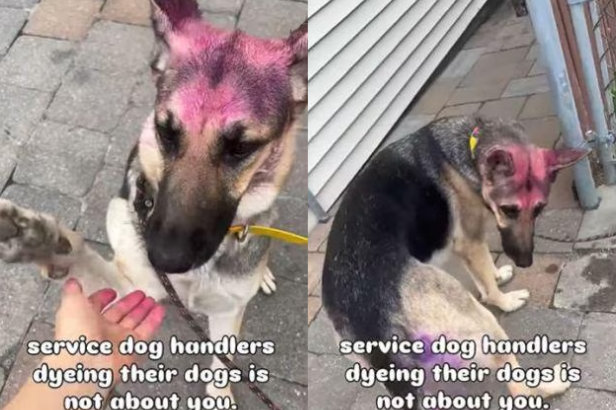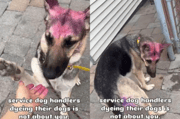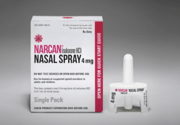
A bright pink German Shepherd sparked one of the year’s most heated debates about pet care.
Opinions online clashed fiercely between those who found it cute and those who called it cruel.
The discussion quickly escalated, drawing thousands of comments from concerned pet owners and casual viewers alike.
The controversy began when a social media account shared footage of a German Shepherd service dog with vibrant pink dye on its head and tail.
The post, captioned with a defiant message about service dog handlers’ rights to personalise their working partners, went viral almost immediately.
Many viewers were outraged, while others defended the handler’s choice.
Veterinary experts weighed in, offering a more measured perspective than the online arguments suggested.
According to specialists, it is possible to safely dye a pet’s fur when proper precautions are taken.
The catch is that the process carries real risks and requires careful consideration.
Most dog hair dyes use non-toxic, plant-based ingredients designed to be safe for a pup’s skin.
Unlike human hair products, they do not contain chemicals such as bleach or ammonia.
Expert Advice on Safe Pet Dyeing
Dr Caroline Wilde from Trupanion explained: 'Just like with people, risk exists for contact sensitivity, irritation, or burns to the skin even with those dyes deemed safe'.
She emphasised that correct application and realistic safety expectations were key.
Professional groomers recommended that natural and organic pet dyes should be used only occasionally.
Special occasions were preferred over regular touch-ups.
The pink German Shepherd debate revealed deeper concerns than pet grooming alone.
'If your dog has sensitive skin I would 100% avoid using [dye] to be safe.'
One commenter claiming veterinary credentials highlighted a significant risk: 'My only complaint is that you have no idea how many cats and dogs I’ve treated in the ER when their fur was dyed. 'It said it was animal safe'. Ok, I believe you, but it clearly wasn’t.'
Real-Life Risks and Safety Measures
Tragically, incidents like a 2015 case where a kitten died after ingesting toxic pink dye underline the importance of caution.
For pet owners considering fur colouring, veterinary advice included several non-negotiable safety steps.
Experts suggested performing a patch test on a small area 24–48 hours before full application to monitor for reactions.
Professional grooming was recommended as the safest approach.
Pet owners without access to a groomer were advised to consult their vet for guidance.
Safe pet dyeing essentials
Never use human hair dye on pets
Always patch test 24–48 hours before full application
Use only products specifically formulated for pets
Avoid dyeing pets with sensitive or damaged skin
Consider professional grooming for safest results
Keep sessions sporadic, not regular
Broader Pet Welfare Debate
The broader debate raised questions about pet welfare.
Cosmetic changes, such as dyeing a dog’s fur, are elective, and many animal welfare organisations and vets oppose the practice.
Some owners simply enjoy seeing their pets in new colours or costumes for events.
In such cases, responsibility lies with the owner to ensure products are genuinely safe.
Service dogs added complexity to the discussion.
Handlers often face scrutiny over every aspect of care, and one original poster expressed frustration: 'If we want to dye their fur, then guess what? That’s our choice.'
The debate served as a reminder to prioritise facts over online fury.
Dyeing a dog’s hair can be creative and fun, but safety and comfort should always come first, with dyeing considered an occasional treat rather than a routine practice.
What This Means For You
Non-toxic, pet-safe dyes do exist, but they still carry potential risks such as skin irritation and allergic reactions.
Patch testing and professional grooming are essential steps to ensure your dog’s safety before attempting to dye their fur.
Cosmetic fur colouring is purely elective, and many animal welfare experts discourage making it a regular practice.
Service dog owners face additional scrutiny, which highlights the importance of prioritising safety and wellbeing over appearance.
For pet owners, especially those who may be newer to modern grooming trends, these points serve as a reminder that any decision to alter a pet’s natural look should be made carefully, with veterinary guidance, and always with the animal’s comfort and health as the top priority.
The pink German Shepherd debate highlights how even well-intentioned grooming decisions can spark controversy and raise serious safety concerns.
Sometimes, grooming choices go beyond aesthetics and have real consequences for a pet’s wellbeing.
For a striking example of the risks involved in professional pet care, this next story shows how a grooming incident led to legal action and a hefty fine.
Read more: Dog groomer faces $7500 fine after shocking treatment to customer’s pet
Animal abuse debate erupts over video of pink-dyed German Shepherd as service dog handlers hit back at critics of the cute act — Reports on a viral video of a German Shepherd dyed bright pink, sparking online debate over pet care and service dog handling.
[https://www.skynews.com.au/lifesty...t/news-story/cee6a3737aaaa71e54482e99c53c6fd6(https://www.skynews.com.au/lifestyl...story/cee6a3737aaaa71e54482e99c53c6fd6[/URL)]
Is it Okay to Dye Your Pet? | Pet Parenting — Explains that pets’ fur can be safely dyed if done properly, but there are risks and precautions to consider.
[https://www.trupanion.com/pet-blog/article/pet-fur-dye-safety(https://www.trupanion.com/pet-blog/article/pet-fur-dye-safety[/URL)]
Dog Hair Dyeing, A Vet Weighs In On If It's Safe—Parade Pets — Veterinary advice confirms that non-toxic dyes can be safe, with recommendations for patch testing and monitoring for reactions.
[https://paradepets.com/dogs/is-dog-hair-dyeing-safe(https://paradepets.com/dogs/is-dog-hair-dyeing-safe[/URL)]
Dog Hair Dye: Is It Safe? Vet-Verified Facts & Risks | PangoVet — Details that most dog hair dyes are plant-based and safe for skin, but human dyes contain harmful chemicals and cosmetic dyeing is generally discouraged by vets.
[https://resources.pangovet.com/pet-health-wellness/dogs/is-dog-hair-dye-safe/(https://resources.pangovet.com/pet-health-wellness/dogs/is-dog-hair-dye-safe/[/URL)]
Dog Hair Dye: Read this Guide Before You Try for Expert Tips and Recs — Provides expert guidance on safe use of all-natural and organic dyes for pets, recommending sporadic use rather than regular dyeing.
[https://www.rover.com/blog/dog-fur-dye-everything-you-need-to-know-before-you-try-it/(https://www.rover.com/blog/dog-fur-dye-everything-you-need-to-know-before-you-try-it/[/URL)]
Is Hair Dye Safe for Dogs? | Hill's Pet — Advises that professional grooming is the safest method for dyeing a dog’s hair, and vets can provide guidance if no groomer is available.
[https://www.hillspet.com/dog-care/resources/is-hair-dye-safe-for-dogs(https://www.hillspet.com/dog-care/resources/is-hair-dye-safe-for-dogs[/URL)]
Coloring Your Canine Companion: Safe Dyeing Tips for Your Dog's Fur — Highlights that dyeing a dog’s hair can be creative and fun, but safety and proper guidelines are essential for a positive experience.
[https://thevets.com/blog/dog-hair-dye/(https://thevets.com/blog/dog-hair-dye/[/URL)]
Have you ever considered adding colour to your furry friend’s coat, or do you prefer to keep things natural?







